Design Journal: Villains
I'm gonna talk about how we're designing a major new feature we're calling Villains. I'll start with some history and background to cover the motivation, and then I'll get into our proposed solution (that we've started building), along with some of the risks and pitfalls that we hope to avoid in the process.
NOTE: very mild (trailer-level) spoilers below.
Something we've had a lot of trouble with, ever since the beginning, was an overarching story.
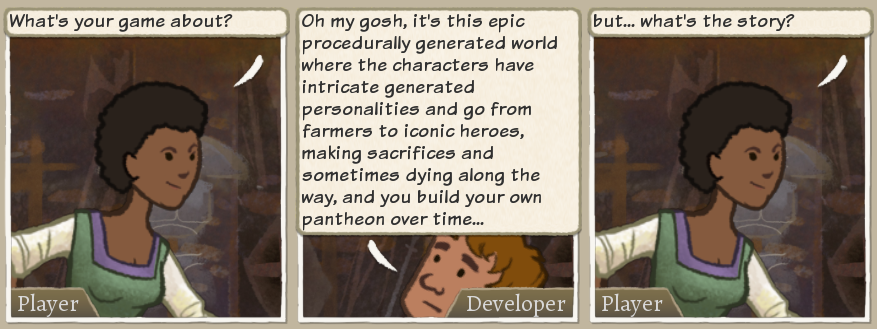
At first we had this vague sense that you were sortof "settling" the land, making it safe from monsters, that sort of thing. And once we went down the procedural heroes and fights path, we didn't want to marry ourselves to a particular overall storyline either. Here's why.
Right now, if you play the game 5 times, you'll get a different cast of heroes each time, and you'll (hopefully!) see new and different events each time. That's cool! But if we had a set plot with scripted events, then those would quickly become boring. That's why our "overarching" plot is as thin as possible. There are monsters. Stop them. It's enough to point you in a direction, and that's all it does. It's intended to melt into the background after that.
 This isn't a story. It's not pretending to be.
This isn't a story. It's not pretending to be.
But ok, it's not super satisfying. One of the big goals for our game is to be a kind of storytelling tool, so that players can play out their own unique epic stories. But, so far we've simply ignored or handwaved the whole main motivation for being heroes in the first place. Why are you here? What do you want? We just rely on genre tropes and it's not satisfying.
A long time ago we had an idea for a cast of Villains, that maybe you'd pick one, or randomly get one in each game, and they would provide the story for that playthrough. We tried going down that road and we had to stop, because the story we were creating was brittle, it couldn't handle a hero dying partway through a plot arc, etc.. It took a long time to write and it wouldn't take very long to play, and once you had played it, you wouldn't want to play it again.
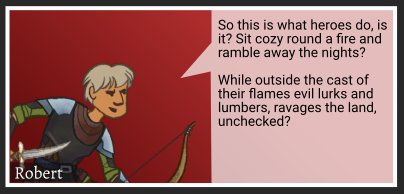 We used to have NPCs who had personal relationships with specific heroes, and would guide you through the plot
We used to have NPCs who had personal relationships with specific heroes, and would guide you through the plot
So we abandoned that route and starting writing events that could be triggered randomly, when the heroes arrive at a hostile site, for example. (This is pretty much the approach that FTL uses, along with having a very thing overarching plot.) That's where we've been focusing our efforts over the last couple years, and it's paid off. So now we have a game that we can play over and over again, which is pretty great.
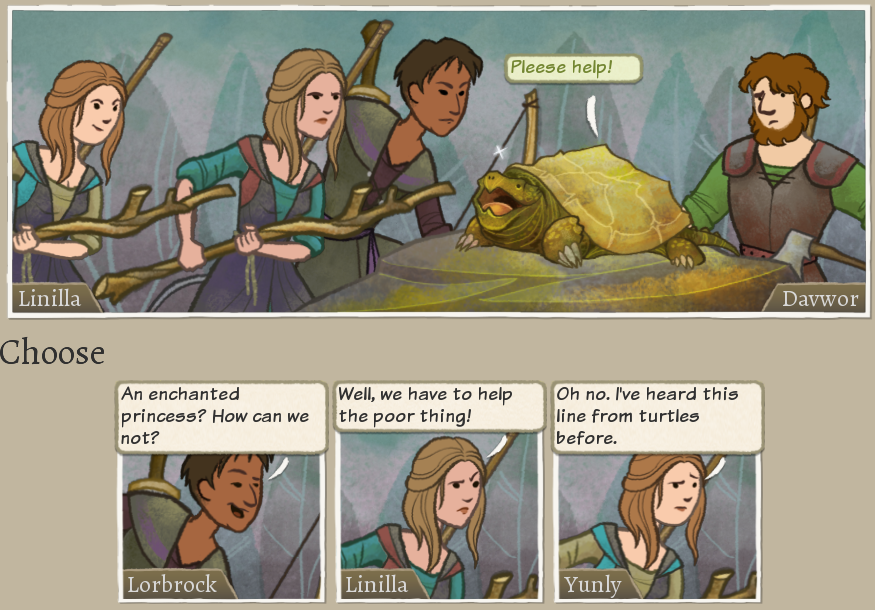 Ah, the essential choice!
Ah, the essential choice!
But, the downside is that our overall campaign doesn't really feel unique or important. Fight some monsters, fight some different monsters. Ok. What can we do about that? This is one of our most requested improvements, so we've got to tackle it.
Here's some of the stuff we thought about.
Procedural Chapters
Our first thought was to see if we could come up with more interesting chapters procedurally. We'd define a bunch of different chapter goals, and each campaign you'd get a handful of them, and that would make it feel different, right? Well, maybe. But probably what would happen instead is the second time you got the "rescue the npc" chapter you would recognize it and stop paying attention to it. And also, a mish mash of different things happening, and then a big final battle isn't a story. It's a history, maybe, but not a story, because it's not connected; it doesn't make sense from start to finish.
Simulation Driven
Another approach is to deepen our simulation. What if we modeled more things in the world, like town population, human and monstrous economy, and so forth. Then the monsters could do things for simulation reasons, and that would create a natural tension, and generate story, right? Again, maybe...? But you'd need a pretty deep simulation, and even then you'd (trust me!) want some kind of "storyteller" to make stuff happen at dramatically appropriate times, to keep the conflict at the right level, etc.. At the end of the day it's difficult to imagine building an economy so detailed that it could organically generate a goal like, "we have to beat the Gorgons to the legendary spear!" Which, let's be honest, is the kind of goal that would be perfect for our chapters.
Legacy Monsters
Another approach is to leverage our Legacy mechanics. What if we had legacy monsters, who could serve as mini-bosses and eventually villains? Ok, that sounds pretty damn cool. But! There are design problems also, like, how is a legacy monster created? Is the player incentivized to do weird things in order to get the legacy monsters they want and avoid the ones they don't want? Those incentives are going to clash with story incentives and that will probably feel shitty! But if we gate narrative progress on unlocking legacy monsters, then we need to make sure you're unlocking some. And, if you don't have any control, then they're not really yours, are they? These problems might be solvable, and I do want to revisit legacy monsters some day. But the last problem is, a monster isn't the same thing as a story. If you have a real mean deer, that's cool! But that doesn't necessarily make a good chapter goal, and it definitely doesn't translate into an overall story. We would still need to solve that problem.
Villains Again
We reconsidered our old idea to have individually hand-crafted, bespoke artisan villains. Now that the bulk of the game is (broadly and hopefully) doing the job of character development and hero progression, what if we write a set of villains that can replace those loose "chapter goal" screens from before? If we leave the bulk of the game in place, and really just make villains about the chapter start and capstone fight, then suddenly we can tell one complete story, with interesting plot points along the way, but it's still really different every time you play. Unlike our previous approach, we're no-longer trying to connect every fight. We just want to set one or two goals per chapter that drive the story forward. That's the dream anyway. Let's dig in some more.
Let's talk production. In order for this to work, we need to be able to write new villains faster than people can get bored of the game, basically. We kindof figure if we can release one villain every month or two, and each villain is satisfying for a whole campaign, then that's a great start. If we have 5 villains when we hit 1.0, people will have to play 5 campaigns to see all the story, and by then we're working on villains 6-8. This is the cold hard math of game development, you guys!
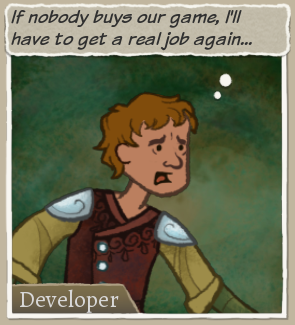
So then, we took this idea and developed it some more, and laid down some guidelines for ourselves, for how to write villains.
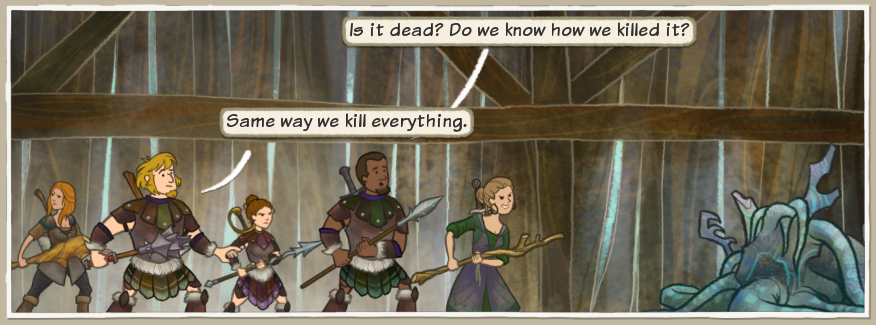
Here are the rough outlines.
Unlockable
New players will have access to one story, which will start with current tutorial material. Completing this will unlock the next batch of villains. Subsequent villains might require a number of legacy heroes at a particular tier, or have other unlock conditions. This allows those stories to, for example, start you off in a dramatically different situation, with a handful of seasoned veterans and 12 calamities on the board. It should open up some fun stories.
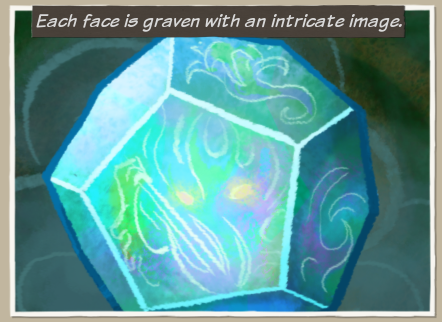
Failing Chapters
You will be able to fail (some) chapter goals without causing a game over. This allows us to have a much broader range of chapter goals, like, "rescue a hero and bring them to the final fight" or "complete this task before year 12." Chapter goals can be story-driven, and failure will have consequences, which will probably be fairly uniform (e.g. extra calamities).
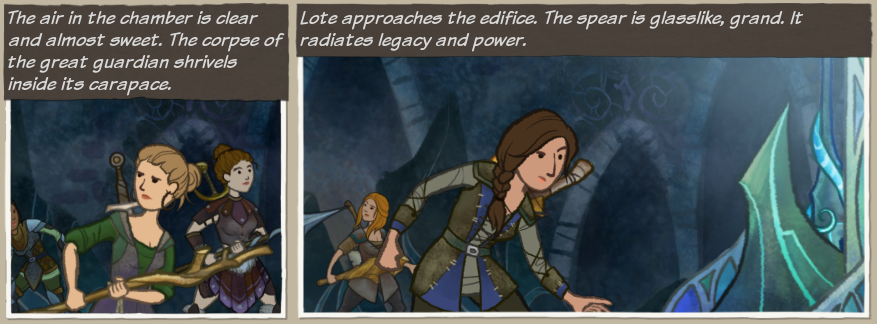
No One Hero is the Main Character
You can have a "special" hero for 1 chapter at most. This rule is important because heroes can die or retire, and if the overall plot depends on a particular hero, that won't work. So, you can have a chapter 1 goal to keep a particular hero alive, but you must allow the goal to fail, and therefore you can't require the same hero in chapter 2.
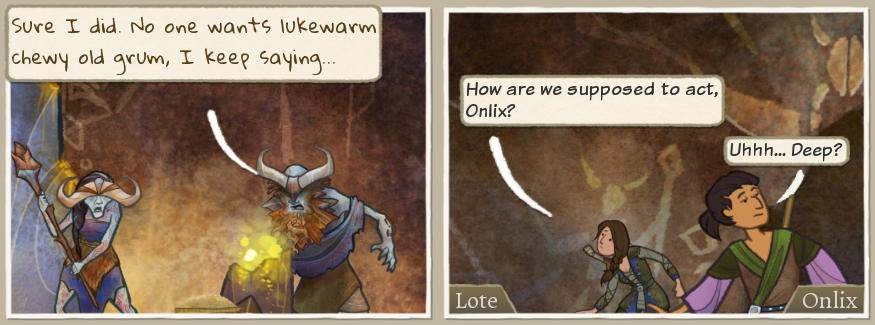
Give Structure and Meaning
Villain content won't change or replace the bulk of our existing content. Villains are there to provide meaning and structure that spans the whole campaign, but don't need to be involved in every single fight. We think the meat and potatoes we've got in the game now is working well, so we won't be breaking it. Complexity-wise, expect each villain story to have one or two big choices, which might be about whether you succeed or fail at a chapter goal.
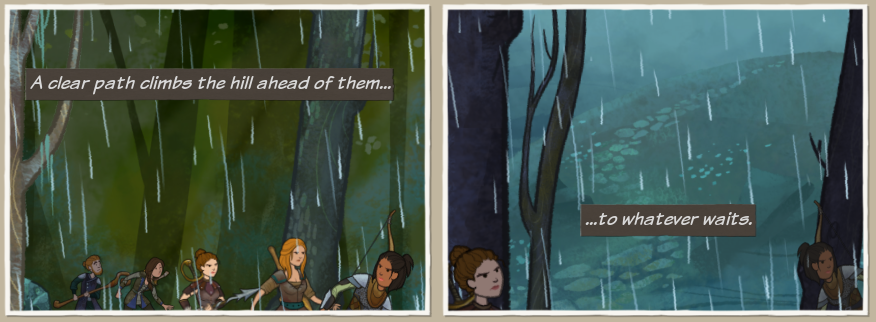
The first villain took about a month to write, and has not yet been integrated. We'll need to build some tech for that, but we don't expect tech to be the blocker for long. We expect subsequent villains to be pretty straightforward, tech-wise. We plan to turn the feature on when we have 3 complete villains. We may or may not disable the old-style campaigns at that time.
Are we building the right thing? Maybe this isn't what you want. Maybe it will take away from the sense of a story that you own completely, and make Wildermyth more like all the other RPGs out there? I worry about that! Maybe this will make the dynamic writing and procedural storytelling that we do less obvious, and will ultimately ruin the game? What if we have five villains, and when you play them all, you're done with the game? Maybe we'll want to preserve and/or even expand a "simulation mode" where there is no one set story?
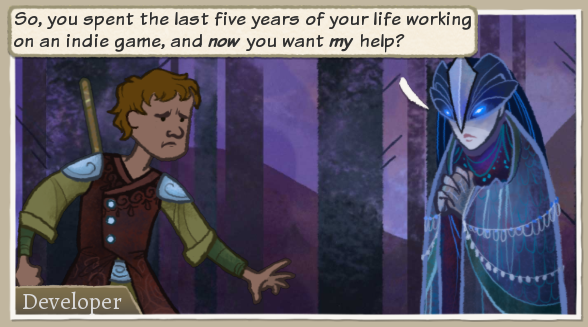
...we have no idea I guess! But we think if we can produce new villains fast enough, then the upside of having more stories will outweigh the downsides of moving away from some kind of procedural purity. Time will tell! But let us know if you have a guess one way or another!
In the course of building Villains, we're going to need to build a bunch of special maps, and we'll need to build a structure that makes it easy for us to string stories together over a whole campaign, easily handle failure, etc.. Those things aren't too far away from what the game already does so I'm not too concerned, but I think it opens up some really cool possibilities.
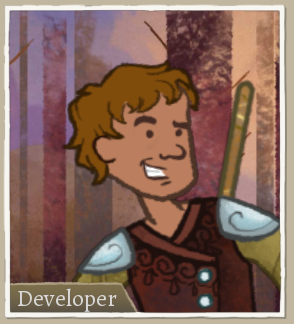
What if anyone can write their own villain? What if you can build your own battle maps, and string them together with your own comics? That's the thing that I'm the most excited about, and what I think really convinced us that this was an exciting direction. Can we make tools that will allow you to really and truly tell your own story, that anyone can play through with their own heroes? I think we're alarmingly close to being able to answer that question.
Thanks for reading, and let us know what you think! We're listening!
NOTE: very mild (trailer-level) spoilers below.
Background
Something we've had a lot of trouble with, ever since the beginning, was an overarching story.

At first we had this vague sense that you were sortof "settling" the land, making it safe from monsters, that sort of thing. And once we went down the procedural heroes and fights path, we didn't want to marry ourselves to a particular overall storyline either. Here's why.
Right now, if you play the game 5 times, you'll get a different cast of heroes each time, and you'll (hopefully!) see new and different events each time. That's cool! But if we had a set plot with scripted events, then those would quickly become boring. That's why our "overarching" plot is as thin as possible. There are monsters. Stop them. It's enough to point you in a direction, and that's all it does. It's intended to melt into the background after that.
 This isn't a story. It's not pretending to be.
This isn't a story. It's not pretending to be.But ok, it's not super satisfying. One of the big goals for our game is to be a kind of storytelling tool, so that players can play out their own unique epic stories. But, so far we've simply ignored or handwaved the whole main motivation for being heroes in the first place. Why are you here? What do you want? We just rely on genre tropes and it's not satisfying.
A long time ago we had an idea for a cast of Villains, that maybe you'd pick one, or randomly get one in each game, and they would provide the story for that playthrough. We tried going down that road and we had to stop, because the story we were creating was brittle, it couldn't handle a hero dying partway through a plot arc, etc.. It took a long time to write and it wouldn't take very long to play, and once you had played it, you wouldn't want to play it again.
 We used to have NPCs who had personal relationships with specific heroes, and would guide you through the plot
We used to have NPCs who had personal relationships with specific heroes, and would guide you through the plotSo we abandoned that route and starting writing events that could be triggered randomly, when the heroes arrive at a hostile site, for example. (This is pretty much the approach that FTL uses, along with having a very thing overarching plot.) That's where we've been focusing our efforts over the last couple years, and it's paid off. So now we have a game that we can play over and over again, which is pretty great.
 Ah, the essential choice!
Ah, the essential choice!But, the downside is that our overall campaign doesn't really feel unique or important. Fight some monsters, fight some different monsters. Ok. What can we do about that? This is one of our most requested improvements, so we've got to tackle it.
Alternatives
Here's some of the stuff we thought about.
Procedural Chapters
Our first thought was to see if we could come up with more interesting chapters procedurally. We'd define a bunch of different chapter goals, and each campaign you'd get a handful of them, and that would make it feel different, right? Well, maybe. But probably what would happen instead is the second time you got the "rescue the npc" chapter you would recognize it and stop paying attention to it. And also, a mish mash of different things happening, and then a big final battle isn't a story. It's a history, maybe, but not a story, because it's not connected; it doesn't make sense from start to finish.
Simulation Driven
Another approach is to deepen our simulation. What if we modeled more things in the world, like town population, human and monstrous economy, and so forth. Then the monsters could do things for simulation reasons, and that would create a natural tension, and generate story, right? Again, maybe...? But you'd need a pretty deep simulation, and even then you'd (trust me!) want some kind of "storyteller" to make stuff happen at dramatically appropriate times, to keep the conflict at the right level, etc.. At the end of the day it's difficult to imagine building an economy so detailed that it could organically generate a goal like, "we have to beat the Gorgons to the legendary spear!" Which, let's be honest, is the kind of goal that would be perfect for our chapters.
Legacy Monsters
Another approach is to leverage our Legacy mechanics. What if we had legacy monsters, who could serve as mini-bosses and eventually villains? Ok, that sounds pretty damn cool. But! There are design problems also, like, how is a legacy monster created? Is the player incentivized to do weird things in order to get the legacy monsters they want and avoid the ones they don't want? Those incentives are going to clash with story incentives and that will probably feel shitty! But if we gate narrative progress on unlocking legacy monsters, then we need to make sure you're unlocking some. And, if you don't have any control, then they're not really yours, are they? These problems might be solvable, and I do want to revisit legacy monsters some day. But the last problem is, a monster isn't the same thing as a story. If you have a real mean deer, that's cool! But that doesn't necessarily make a good chapter goal, and it definitely doesn't translate into an overall story. We would still need to solve that problem.
Villains Again
We reconsidered our old idea to have individually hand-crafted, bespoke artisan villains. Now that the bulk of the game is (broadly and hopefully) doing the job of character development and hero progression, what if we write a set of villains that can replace those loose "chapter goal" screens from before? If we leave the bulk of the game in place, and really just make villains about the chapter start and capstone fight, then suddenly we can tell one complete story, with interesting plot points along the way, but it's still really different every time you play. Unlike our previous approach, we're no-longer trying to connect every fight. We just want to set one or two goals per chapter that drive the story forward. That's the dream anyway. Let's dig in some more.
The Design
Let's talk production. In order for this to work, we need to be able to write new villains faster than people can get bored of the game, basically. We kindof figure if we can release one villain every month or two, and each villain is satisfying for a whole campaign, then that's a great start. If we have 5 villains when we hit 1.0, people will have to play 5 campaigns to see all the story, and by then we're working on villains 6-8. This is the cold hard math of game development, you guys!

So then, we took this idea and developed it some more, and laid down some guidelines for ourselves, for how to write villains.

Here are the rough outlines.
Unlockable
New players will have access to one story, which will start with current tutorial material. Completing this will unlock the next batch of villains. Subsequent villains might require a number of legacy heroes at a particular tier, or have other unlock conditions. This allows those stories to, for example, start you off in a dramatically different situation, with a handful of seasoned veterans and 12 calamities on the board. It should open up some fun stories.

Failing Chapters
You will be able to fail (some) chapter goals without causing a game over. This allows us to have a much broader range of chapter goals, like, "rescue a hero and bring them to the final fight" or "complete this task before year 12." Chapter goals can be story-driven, and failure will have consequences, which will probably be fairly uniform (e.g. extra calamities).

No One Hero is the Main Character
You can have a "special" hero for 1 chapter at most. This rule is important because heroes can die or retire, and if the overall plot depends on a particular hero, that won't work. So, you can have a chapter 1 goal to keep a particular hero alive, but you must allow the goal to fail, and therefore you can't require the same hero in chapter 2.

Give Structure and Meaning
Villain content won't change or replace the bulk of our existing content. Villains are there to provide meaning and structure that spans the whole campaign, but don't need to be involved in every single fight. We think the meat and potatoes we've got in the game now is working well, so we won't be breaking it. Complexity-wise, expect each villain story to have one or two big choices, which might be about whether you succeed or fail at a chapter goal.

Roadmap
The first villain took about a month to write, and has not yet been integrated. We'll need to build some tech for that, but we don't expect tech to be the blocker for long. We expect subsequent villains to be pretty straightforward, tech-wise. We plan to turn the feature on when we have 3 complete villains. We may or may not disable the old-style campaigns at that time.
Risks
Are we building the right thing? Maybe this isn't what you want. Maybe it will take away from the sense of a story that you own completely, and make Wildermyth more like all the other RPGs out there? I worry about that! Maybe this will make the dynamic writing and procedural storytelling that we do less obvious, and will ultimately ruin the game? What if we have five villains, and when you play them all, you're done with the game? Maybe we'll want to preserve and/or even expand a "simulation mode" where there is no one set story?

...we have no idea I guess! But we think if we can produce new villains fast enough, then the upside of having more stories will outweigh the downsides of moving away from some kind of procedural purity. Time will tell! But let us know if you have a guess one way or another!
Secret Goals
In the course of building Villains, we're going to need to build a bunch of special maps, and we'll need to build a structure that makes it easy for us to string stories together over a whole campaign, easily handle failure, etc.. Those things aren't too far away from what the game already does so I'm not too concerned, but I think it opens up some really cool possibilities.

What if anyone can write their own villain? What if you can build your own battle maps, and string them together with your own comics? That's the thing that I'm the most excited about, and what I think really convinced us that this was an exciting direction. Can we make tools that will allow you to really and truly tell your own story, that anyone can play through with their own heroes? I think we're alarmingly close to being able to answer that question.
Thanks for reading, and let us know what you think! We're listening!